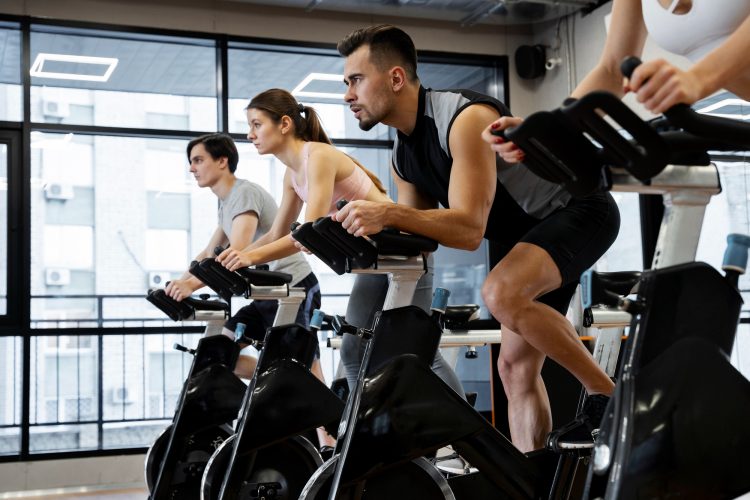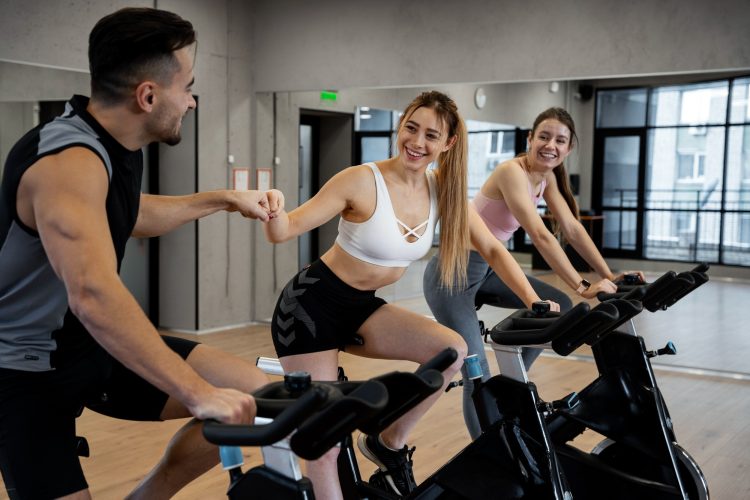Spin classes are a great way to get in a fun, energetic, endurance-building workout. But they can also be time-consuming and hard to fit into a busy schedule. Fortunately, there’s an equally effective alternative, and all you need is a stationary bike and 25 minutes!
As a personal trainer, I’ve witnessed the transformative power of indoor cycling on cardio endurance. I’ve guided numerous individuals in their homes, using nothing more than a stationary bike, to achieve significant improvements. This firsthand experience underscores the effectiveness of indoor cycling when the right program is followed.
In this article, I’ll lay out a super effective 25-minute indoor cycling workout for maximum cardiovascular endurance. I’ll then explore the benefits of using a stationary bike for your endurance workouts, discuss the best type of bike for indoor endurance training, and provide training tips to get maximum benefit from your endurance workouts.
25-Minute Indoor Cycling Endurance Workout
This indoor cycle workout uses variable perceived intensity levels, ranging from 2/10 (gentle) to 9/10 (near-maximum).
These intensity levels are based on Borg’s 0-10 Rating of Perceived Exertion Scale, as follows:
| Level | Perceived Exertion |
| 0 | Rest |
| 1 | Really Easy |
| 2 | Easy |
| 3 | Moderate |
| 4 | Somewhat Hard |
| 5 | Hard |
| 6 | Harder |
| 7 | Really Hard |
| 8 | Really, Really Hard |
| 9 | Near Maximum |
| 10 | Maximum |
Level Up Your Fitness: Join our 💪 strong community in Fitness Volt Newsletter. Get daily inspiration, expert-backed workouts, nutrition tips, the latest in strength sports, and the support you need to reach your goals. Subscribe for free!
Although the intensity level varies widely, you will notice that the RPM rate remains unchanged throughout the workout. That’s because RPM, or revolutions per minute, measures the cadence. Cadence and intensity are independent variables.
The intensity level is controlled by the resistance level applied to the bike’s flywheel. So, you should adjust the resistance level as indicated below. You’ll produce the same number of revolutions each minute, but the difficulty of your pedaling action will change according to the resistance level you set.
Maintaining a consistent cadence while adjusting intensity allows for effective workload control, enabling you to focus on specific training goals such as endurance, strength, or speed.
There are three instances where you have to increase your RPMs to 100. This occurs between minutes 19:00 and 20:00, 21:00 and 21:30, and 22:00 and 22:30. The increased workload required to push for that extra 20 RPMs will significantly increase your cardiovascular endurance.
Here’s the workout:
| Time | Duration | RPE | RPM |
| 0:00 | 1 min | 2/10 | 80 |
| 1:00 | 2 min | 3/10 | 80 |
| 3:00 | 2 min | 4/10 | 80 |
| 5:00 | 1 min | 3/10 | 80 |
| 6:00 | 1 min | 7/10 | 80 |
| 7:00 | 1 min | 5/10 | 80 |
| 8:00 | 2 min | 7/10 | 80 |
| 10:00 | 2 min | 5/10 | 80 |
| 12:00 | 3 min | 7/10 | 80 |
| 15:00 | 3 min | 5/10 | 80 |
| 18:00 | 1 min | 7/10 | 80 |
| 19:00 | 1 min | 8/10 | 100 |
| 20:00 | 1 min | 2/10 | 80 |
| 21:00 | 30 sec | 8/10 | 100 |
| 21:30 | 30 sec | 2/10 | 80 |
| 22:00 | 30 sec | 8/10 | 100 |
| 22:30 | 1 min | 9/10 | 80 |
| 23:00 | 2 min | 3/10 | 80 |
Why Use a Stationary Bike for Endurance Training
There are several benefits to using a stationary bike in your home rather than training outdoors or in a spin class.
Controlled Environment
Training in the familiar surroundings of your home puts you in total control of your workout. To make meaningful improvements to your cardio endurance, you’ve got to be focused in the saddle. But how focused can you be outdoors when you’ve got to be on constant alert for dogs, kids, traffic, and stop signs?
You don’t have any of those distractions when you’re training indoors. That allows you to give 100 percent focus to your workout’s constantly changing intensity and cadence levels. Because you don’t have to make unscheduled stops and starts, you can also remain in an aerodynamic position for an extended period.
A 2017 study that involved 24 female middle school students compared the effects of indoor spin bike training with outdoor cycling over a 16-week training period. The 12 girls who trained on the spin bikes had significantly better cardio endurance, body fat percentage, and heart rate results. [1]
The endurance workout above gets very intense toward the end when your intensity level goes up to an eight and nine RPE. Try doing it on the road; you risk losing control and drifting into traffic. Those worries don’t exist when you’re working out at home.
Working out at home frees you from the fixed schedule of spin classes. Rather than adjusting your schedule to fit the gym’s timetable, you can do your endurance training at a time that suits you.
You can also set up your workout environment at home. You can choose the music, temperature, and lighting to maximize your enthusiasm and motivation to train.
You’ve also got the freedom to design your workouts based on your training goals, fitness level, and identified needs. In a spin class, the intensity, duration, and cadence levels are set to cover a group. As a result, you’re likely to spend some of the session working at a level that doesn’t fit your needs.
At home, you control the resistance and intensity levels. Rather than fitting in with the crowd, you can tailor the variables of the workout to your training needs.
Eliminates Commute Time
A few years ago, I committed to a three-month spin class program to strip off body fat. The classes were great for burning calories, but the commute took twice as long as the workout itself!
That experience underscores the time-saving benefit of working out at home. Plus, having your workout on tap makes you far more likely to actually do it!
Consistent Equipment
You’ll probably sit on a different bike every time you attend a spin class, and you have to get used to a different bike model or setup. At home, though, you only have to adjust your bike once, and then it’s set for life.
Privacy and Comfort
Training at home provides you with a sense of privacy and comfort. You don’t have to feel self-conscious about other people judging you or feel the need to keep up with someone else. You can give 100 percent focus to your workout rather than worrying about external factors that can distract or inhibit your performance.
Level Up Your Fitness: Join our 💪 strong community in Fitness Volt Newsletter. Get daily inspiration, expert-backed workouts, nutrition tips, the latest in strength sports, and the support you need to reach your goals. Subscribe for free!
What Type of Bike is Best for Indoor Endurance Training?
There’s a reason that spin cycle classes are so popular for general fitness and endurance training: spin bikes deliver an excellent workout!
A spin cycle most closely replicates the outdoor riding experience. Spin cycles have the heaviest flywheel of all bike types, situated at the front of the unit.
Spin cycles feature a fixed gear, which keeps the pedals revolving even when you are not actively pushing down. The crankshaft of a spin bike is similar to that of an outdoor bike. You can stand up while pedaling, just like on an outdoor uphill ride.
Spin cycles use a flywheel to provide resistance. This is the power base of the bike that provides the resistance and determines how fluid and realistic the pedaling experience is. You can also find flywheels on upright and recumbent bikes, but those on spin bikes are much heavier.
Spin cycles are more spartan than upright and recumbent bikes, with few accessories, a smaller seat, and little in the way of monitor technology. Unlike upright cycles, the handlebars on a spin cycle are positioned slightly lower than the seat. This more closely replicates the seat position on a road bike. It also encourages you to rise out of the seat while pedaling intensely.
Spin cycles are ideally suited for experienced outdoor cyclists and those who want to replicate a spin class session at home. They are also an excellent way for people who want to lose weight fast and burn many calories.
Spin bikes often feature interactive features such as tracking performance metrics, connectivity to fitness apps, and virtual training programs to keep you challenged and stimulated.
Exercise physiologist Dr. Stacey Sims advocates spin cycling for endurance. In a recent YouTube video, she said:
“Spin bike endurance training provides a versatile platform for targeting different energy systems, including aerobic and anaerobic pathways, through varied workouts such as steady-state rides, intervals, and hill climbs. This diversity in training stimuli can lead to greater cardiovascular fitness, muscular endurance, and metabolic efficiency adaptations.”
Spin cycle YouTube influencer and competitive cyclist Kirsten Allen offers the following advice when buying a spin cycle for your endurance workouts:
“The most important thing to look out for is flywheel weight. The heavier the flywheel, the smoother the ride. Look for a flywheel between 14 and 20 kilograms (30 to 44 pounds). The second most important thing is the type of resistance: magnetic or friction. Magnetic resistance is quieter and has lower maintenance. Number three is the type of drive. A belt drive is quieter and has less short-term maintenance than a chain drive. However, chain belt drives will last longer.”
Indoor Cycle Endurance Training Tips
Here are a few tips to maximize your performance:
Build a Cycling Habit
The key to increasing your aerobic endurance is consistently pushing beyond yourself each week. There’s not much benefit in doing a marathon multi-hour session and then spending several days recovering.
You’re much better doing shorter, more frequent sessions (like the one outlined above), gradually increasing the intensity as you get fitter.
Use ERG Mode
ERG mode is short for ergometer mode. This feature automatically adjusts the resistance to maintain the intensity level you set independently of the cadence.
ERG mode gives you greater control over the resistance, helping you meet your training goals and track your metrics more accurately.
Include Longer Rides
To build endurance, you’ve got to train with high intensity and over a long duration. The 25-minute workout provided here does a great job of providing the intensity part of that equation.
To cover the longer duration aspect, you should alternate between a 25-minute and 60-minute workout at a more consistent intensity. During this longer workout, maintain an RPE of four and an ROM of 80.
Include Standing Start Sprints
Standing start sprints are an excellent way to improve your speed and endurance on the bike. Start with the bike in a high gear and pedal at a very low RPM so your legs barely move. Then, sprint at maximum ability for 20 seconds. After that, pedal slowly for two minutes.
Build up to doing six sets of these standing sprints throughout your workout,
Stay Hydrated
When you start your workout, ensure you have a full water bottle within reach. Take small sips when you are working at a low-intensity level. Adding an electrolyte powder to your water bottle will help you replace minerals lost through sweat.
Stretch Post-Workout
After your endurance workout, spend a few minutes doing static stretching exercises targeting your quads, glutes, hamstrings, back, and chest. Hold each stretch for 30 seconds. This will improve flexibility and help reduce delayed-onset muscle soreness (DOMS).
Do not do static stretching before your cycle workout, as research shows it can reduce cycling economy. For example, a 2011 study had 10 highly trained endurance cyclists working out with and without first doing a series of static stretches. Results showed that the cyclists were significantly slower on a 5-minute time trial after static stretching. [2]
Wrap Up
You only need a spin bike and 25 minutes for an effective endurance training workout. Do the sample workout provided in this article every other day. On alternate days, go for a longer ride (around 60 minutes) at a more moderate, steady intensity (RPE of four).
Remember, consistency is key to building your cardio endurance. So, find the best time for you, schedule your workouts, grab your water bottle, and just do it!
References
- Yoon JG, Kim SH, Rhyu HS. Effects of 16-week spinning and bicycle exercise on body composition, physical fitness and blood variables of middle school students. J Exerc Rehabil. 2017 Aug 29;13(4):400-404. doi: 10.12965/jer.1735052.526. PMID: 29114504; PMCID: PMC5667616.
- Wolfe AE, Brown LE, Coburn JW, Kersey RD, Bottaro M. Time course of the effects of static stretching on cycling economy. J Strength Cond Res. 2011 Nov;25(11):2980-4. doi: 10.1519/JSC.0b013e318234e55f. PMID: 21904241.










